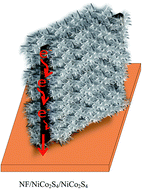A hierarchical NiCo2S4 honeycomb/NiCo2S4 nanosheet core–shell structure for supercapacitor applications
Abstract
Transition metal sulphides are becoming one of the promising materials for energy storage applications. Particularly, an advanced electrode material architecture, which gives favourable electronic and ionic conductivity, is highly in demand. Herein, a hierarchical NiCo2S4 honeycomb/NiCo2S4 nanosheet core–shell structure is reported for supercapacitor applications. The core–shell structure was in situ grown on a nickel foam via two consecutive hydrothermal processes, followed by an electrochemical deposition process. Moreover, we tuned the deposition cycle to get abundant active sites with gaps of suitable sizes between the walls of the honeycomb structure for efficient electrolyte diffusion routes. The 3D honeycomb core structure was used as superhighway for electron transport to the current collector, while the ultrathin shell structure offered a large surface area with short electron and ion diffusion paths, thus leading to the faster kinetics and higher utilization of active materials. Thus, using the synergistic advantages of the core material and the shell material, the as-synthesized optimized electrode material came up with an excellent specific capacitance of 17.56 F cm−2 at a current density of 5 mA cm−2 and the highest cycling stability of 88.2% after 5000 cycles of charge–discharge process. Such advanced electrode architectures are highly promising for the future electrode materials.



 Please wait while we load your content...
Please wait while we load your content...